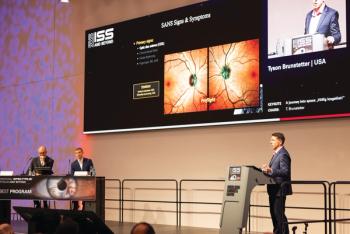
Progress in corneal biomechanics
Researchers are looking into corneal biomechanics as a means to screen patients for keratectasia. The authors review signal interpretation from a non-contact applanation tonometer as it relates to corneal biomechanical indices such as corneal hysteresis.
Ectasia
Corneal biomechanics
Corneal biomechanics also has the potential to improve outcomes in refractive surgery, not to mention the ability to measure correctly the IOP that is relevant for every general ophthalmologist. Therefore, the ability to measure and understand biomechanical properties in vivo has long been sought by refractive surgeons. The January 2005 (Volume 31, Issue 1) special issue on corneal biomechanics of the Journal of Cataract & Refractive Surgery, guest edited by Cynthia Roberts, PhD, introduced the concept of biomechanical customisation in refractive surgery.5
Until the commercial introduction of the non-contact applanation tonometer at the 2005 European Society of Cataract and Refractive Surgeons annual meeting in Lisbon, Portugal, however, corneal biomechanical evaluations were limited to in vitro studies in the laboratory and to virtual mathematical corneal finite element models. The device was designed as an improvement in non-contact tonometry (NCT) with the goal of providing a more accurate measurement of IOP through the understanding of corneal properties. The advantage over standard NCT was based on a precisely metered collimated air pulse and a quantitative electro-optical system that monitors the deformation of the cornea through the corneal reflex of an infrared light.
During the tonometer measurement, the air pressure forces the cornea to deform inward, passing applanation into a slight concavity until the air pump shuts off and the cornea gradually recovers its normal configuration, passing through a second applanation state. The applanation events are registered by a peak on the corneal reflex signal that monitors the entire process. The peak pressure of the air pulse is controlled according to the first applanation event, when an internal command on the instrument shuts off the air pump. Thus, two independent values are obtained for the pressure of the air pulse at the moments of the inward (P1) and outward (P2) applanation events.
Because of energy absorption, or corneal damping related to its viscoelasticity, the inward and outward applanation events are delayed, resulting in two different pressures. The pressure measurements (P1 and P2) were the basis for all calculated variables reported by the original tonometer software (Table 1). The difference between the two pressures is called corneal hysteresis (CH), a new concept when introduced to the ophthalmology community. The term "hysteresis" is derived from an ancient Greek word meaning "lagging behind."
Newsletter
Get the essential updates shaping the future of pharma manufacturing and compliance—subscribe today to Pharmaceutical Technology and never miss a breakthrough.












































